Author: Ignas
Translation: Deep Tide TechFlow
Now it's 2032:
In the morning, you wake up at the Four Seasons Hotel, feeling slightly tired. The two Negroni drinks you had last night are still giving you a headache.
A notification pops up: Open the Rabby wallet on the iPhone 23 XXL and find that BTC has dropped 3% overnight. It's another FUD sparked by Sailor's strategy.
However, BTC is still trading at the high of 1.2 million dollars. You smiled, that crazy Udi was actually right!
Looking back, you bought Bitcoin at $114,000 with 3x leverage on the Hyperliquid platform, leading your family to financial freedom.
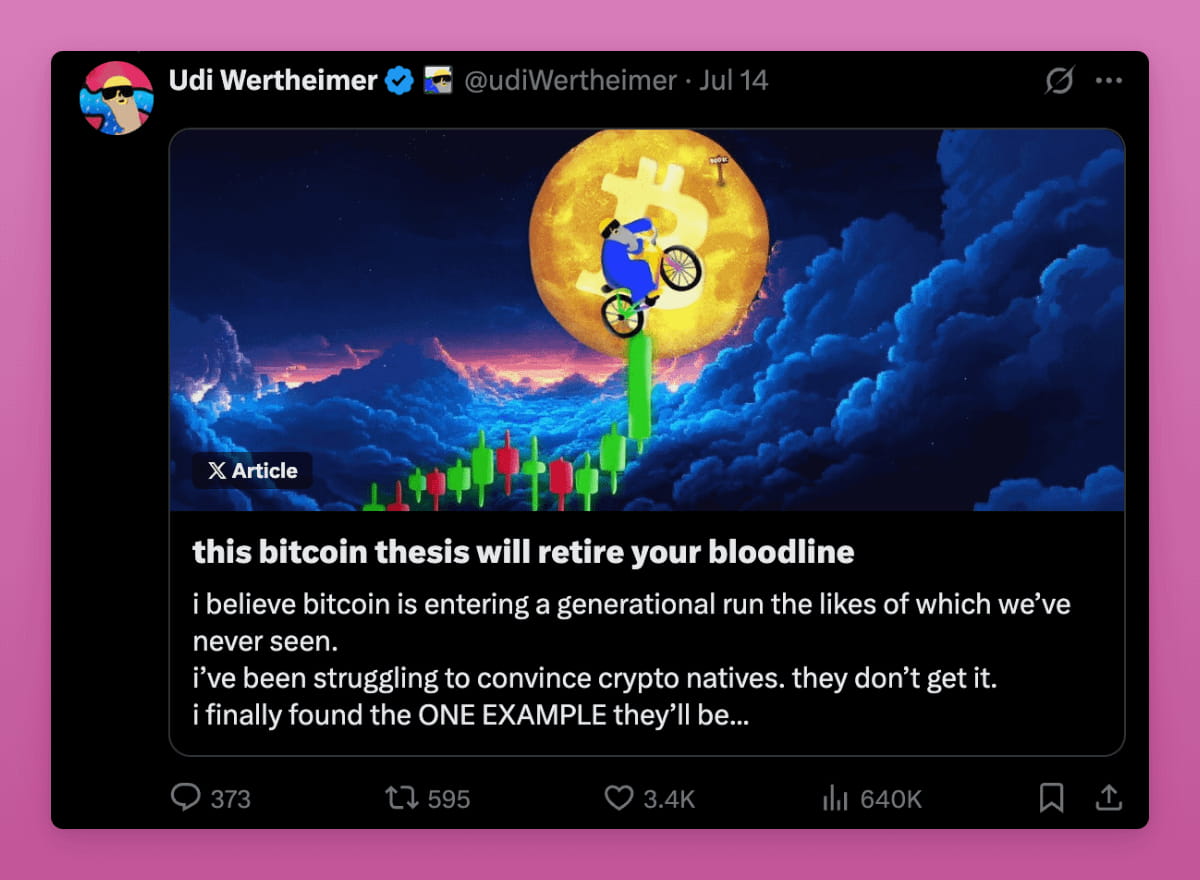
However, Cobie's prediction was slightly off: the hard road is from $80,000 to $250,000, while the easy road is from $250,000 to $1,000,000.

However, the bull market of 2024-29 is indeed different; it marks the official end of the 'four-year cycle' and you are fortunate not to have been liquidated in a 3x leverage trade.
Thanks to Trump's third term, the U.S. successfully acquired 5% of the global Bitcoin supply, bringing a new landscape to the crypto market.
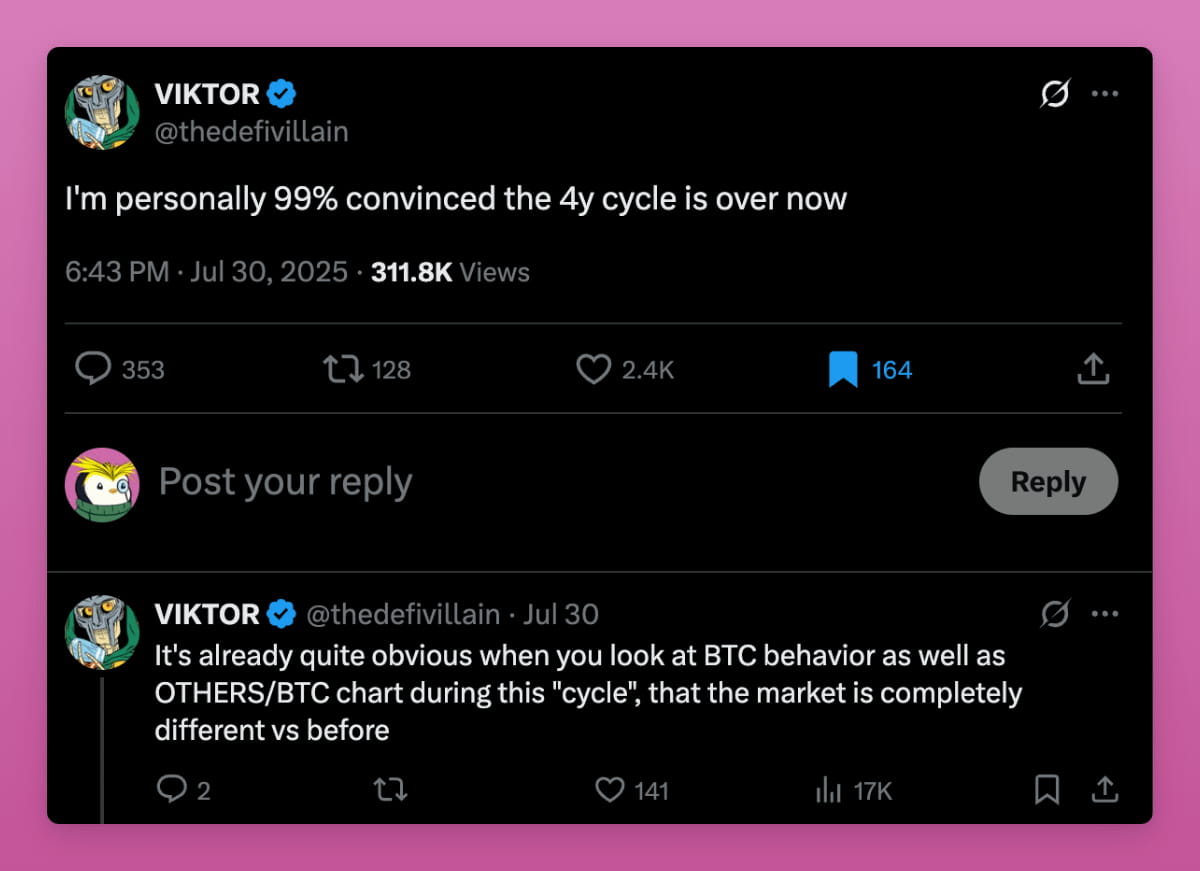
A slight regret surfaces: If I hadn't sold some ETH to OpenAI and SpaceX's private equity back then, I might have owned more. Both companies have not gone public. They tokenized directly on Nasdaq's Ethereum L2.
Nevertheless, tokenized private equity can still serve as collateral for Aave and Fluid.
You can't stop, but dream bigger:
Monad mainnet is online, and the testnet airdrop is coming soon. Once the airdrop arrives, you plan to buy a second home in Antigua and Barbuda, along with the passport. After all, next year the EU will launch a 50% crypto 'solidarity tax,' and you need to prepare.
However, your friend wasn't so lucky.
Experts from the UK (Financial Times) and BBC convinced them to hold euros-CBDC at a 4% annual interest rate as EU defense bonds to save for a down payment on a one-bedroom apartment. With inflation rates as high as 8%, even with a monthly universal basic income of 2,500 euros, this goal is becoming increasingly unattainable.
You feel sad, but it's not your fault: you told them to buy cryptocurrencies. They didn't listen.
Then, you get dressed, brush your teeth, and open the X app. Uh-oh! A notification pops up: 'Please verify your age with a government-issued ID to log in.'

According to UK and soon-to-be EU laws, users will see this message on 'potentially dangerous' content.
Oops! Your VPN just dropped. Set the IP address to Afghanistan and reopen the X app. Success!
Visiting friends in the UK certainly feels different.
Some 'work' needs to be done before flying home.
Cryptocurrency: Selling Dreams
The most powerful selling point of cryptocurrency is its ability to inspire people to dream of a better, more affluent life.
This information is particularly vivid in the current geopolitical and economic climate, standing in stark contrast to people's struggles to pay bills, find jobs, and the increasing erosion of privacy (e.g., the UK's Online Safety Bill).
Scrolling through news, TikTok, and Instagram, despair seems to dominate the information flow, while crypto becomes one of the few lights that ignite hope.
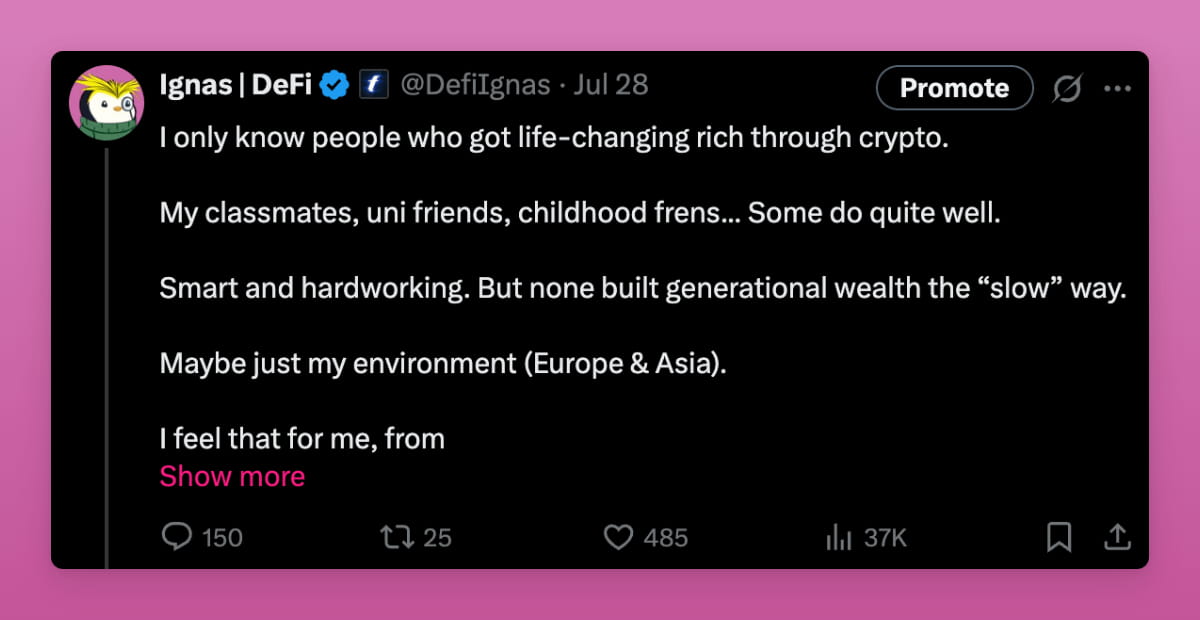
Despite global unrest, the atmosphere on crypto Twitter is particularly positive. Cryptocurrencies and Bitcoin are seen as answers to financial woes. That’s why in my 2032 narrative, I will especially mention the plight of those friends who have not ventured into crypto — their struggles stand in stark contrast to the hope brought by crypto.

Coinbase understood this and conveyed the message accurately.
Their 'Everything is Fine' advertisement about the current state of the UK made me chuckle, but I have to admit, they weren't wrong.

Original video link: Everything is Fine
I love crypto because it's a place where you can unleash 'big dreams.' However, this is also one of the reasons why crypto skeptics dislike us.
They do not believe our story, thinking it is too outrageous and unrealistic. How does blockchain change society? In their eyes, it is just an 'upgraded spreadsheet.'
As Nat Friedman said: "The pessimist seems smart and wise, while the optimist earns real gold."
The great dream capability of cryptocurrencies (and permissionless technology) is also why scammers love our industry: scammers sell a more affluent life but end up ruining it.
I wrote a dedicated article explaining why so many people hate cryptocurrencies.
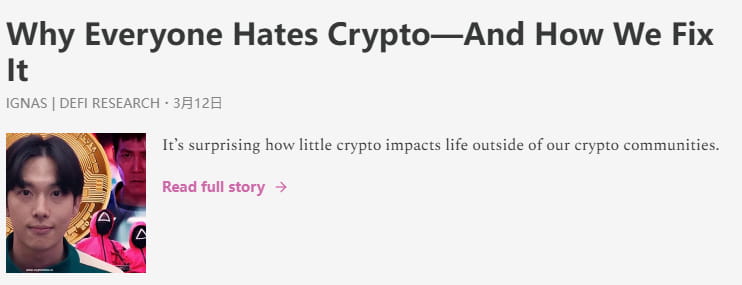
Original link: Why Cryptocurrency is Hated? How Can We Change This?
We are not scammers, and you are not a scammer.
We sincerely believe that cryptocurrencies can positively impact individual lives and society as a whole by strengthening private property, freedom, and financial and internet privacy.
However, despite the tremendous achievements the crypto industry has made in just a few years, I feel that crypto enthusiasts are gradually forgetting how to pursue the 'big dreams.'
Crypto Lost: Forgetting How to Dream
Once, our grand dreams attracted countless retail investors.
But nowadays, why would new retail investors buy ETH? After all, the natives in the crypto circle haven't updated the target price for ETH since the last bull market — still stuck at $10,000.
However, ETH has made so much progress: spot ETFs, adoption by traditional finance, stablecoins, regulation, RWAs (real-world assets), L2 launched by Robinhood, etc.
Is all this effort just for a 2x or 3x short-term gain?
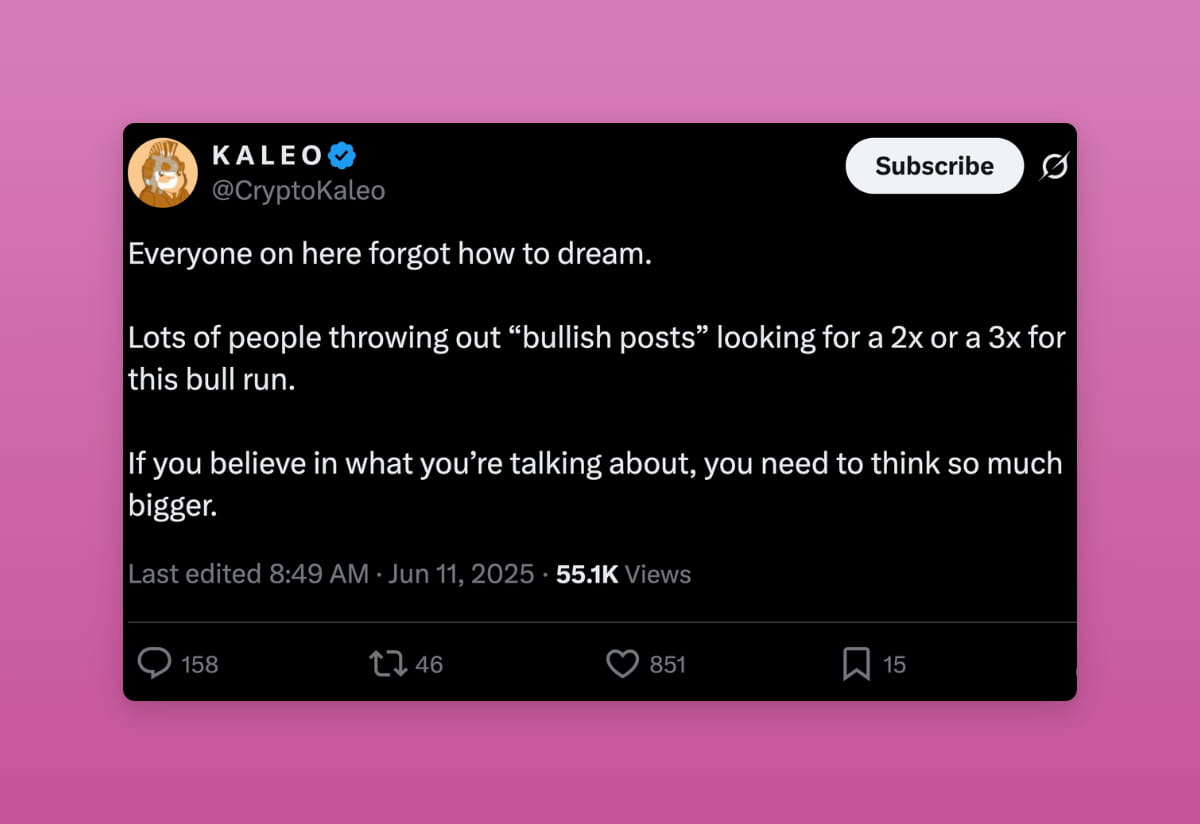
Perhaps we ultimately hope to be taken seriously, so when TradFi joins, Lamborghini and the dream of 'going to the moon' leave the narrative of cryptocurrency.
Now, only those foolish coins (like XRP, ADA, etc.) and Bitcoin can attract dreamers. BTC at least has a hopeful target of 1 million dollars.
ETH and (most) altcoins are not selling big dreams.
But ETH still has hope for a resurgence.
For years, Ethereum enthusiasts have been promoting the meme of 'ultrasound.' But scaling has lowered gas fees and killed the dreams of deflation. (The tech team and marketing team failed to work together!)
The narrative has now returned to fundamentals: institutional adoption, stablecoins, RWAs.
This is nothing new, but this time, it is being told by a louder, more credible voice, like Thomas Lee and Joseph Lubin.
Who tells the story is as important as the story itself.
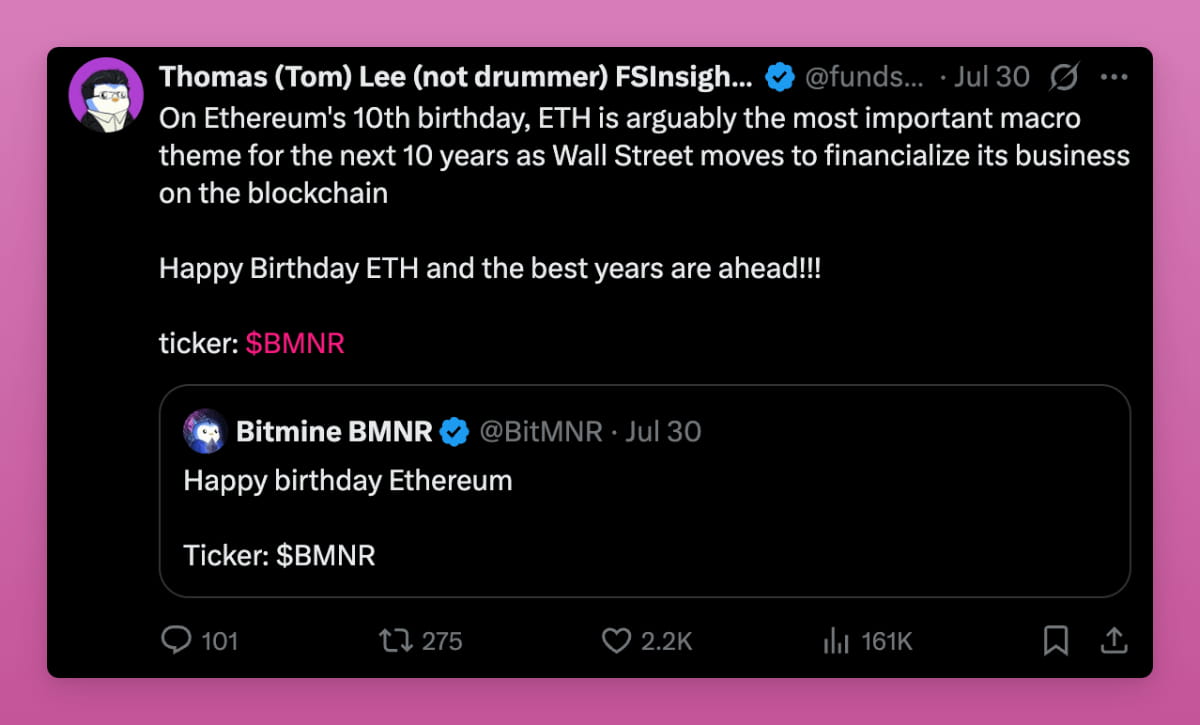
The inclusion of ETH on the balance sheets of public companies has become another catalyst. This not only gives onlooking buyers more confidence, but even bears are beginning to acknowledge that this shift is working.
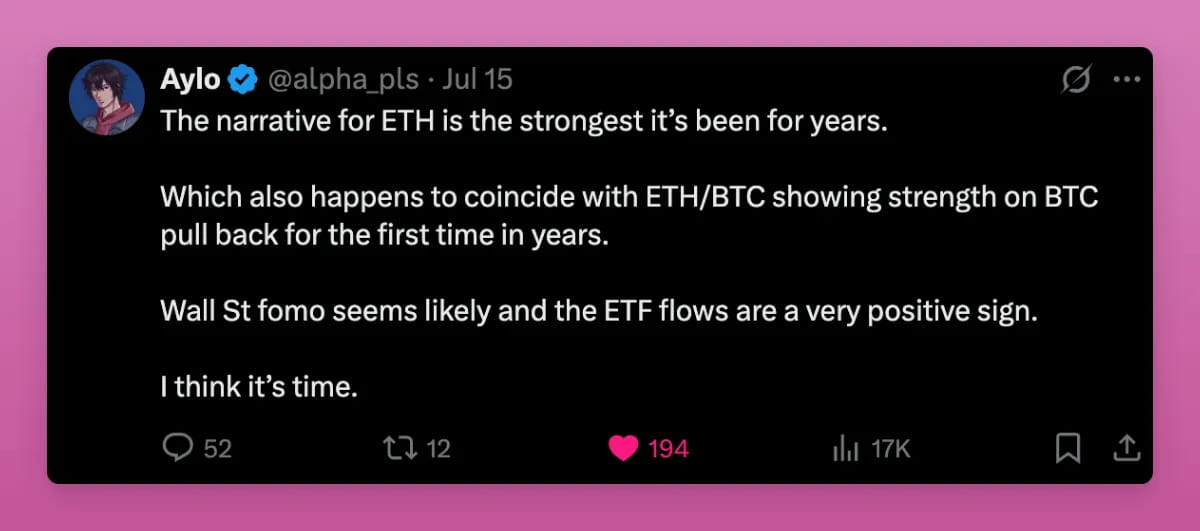
But is all this just for a $10,000 ETH target?
ETH needs to find a more compelling story to push the value of HODLing ETH itself past 10,000 dollars. BTC is digital gold, while ETH... is digital oil?
I believe such a story will eventually happen. Long-term bullish on ETH!
Or take Solana as an example.
In 2024, it flourished with the rags-to-riches story of memecoins. But as memecoin traders suffered losses, Solana and its token SOL also lost their appeal.
SOL is neither a traditional financial chain like ETH nor a value store like BTC; people are losing money on memecoins, which can no longer inspire dreams.
How to make people dream
"When I buy tokens, I want to have big dreams.
However, most projects focus on selling their features rather than their grand goals.
"The existence of tokens can help you realize the dreams of the community." — DefiIgnas said on X.
Looking back, it's amazing that ChainLink's $LINK (an oracle protocol) could enable all of us to have grand dreams.
I thought to myself:
"LINK is the most equitable project we've ever seen. It's ambitious, and if successful, it will truly reshape the social structure." — Popular Copy Pasta
Or take any Compound's COMP as an example. What’s exciting about a lending protocol? Or a decentralized exchange DEX aggregator? A cross-chain protocol?
These tokens inspire people because they belong to a larger movement — DeFi (decentralized finance). Be your own bank, and if you're unhappy with the team's direction, you can vote with tokens through a DAO (decentralized autonomous organization) to make an impact!
Revolutionary!
Now, people do not trust DAOs, and DeFi tokens have become mere investment assets valued solely by income or fees, losing their attractive narratives.

One of my proudest moments
When LINK, COMP, UNI, and YFI were launched, they were the leaders, pioneers, and trailblazers of the DeFi market.
Something brand new.
Now, there is yet another new DEX, lending protocol, oracle, or infrastructure project trying to inspire us or let us have grand dreams.
Is this the price of cryptocurrency becoming a mature asset class?
There are few new projects or TGE announcements on X that excite people, as these projects either offer minor upgrades to current market leaders or involve founders and venture capitalists launching tokens for personal BIG DREAM profits rather than for their communities.
My advice to project founders is: invest time and money to build a coherent narrative, and communicate big dreams through storytelling. Marketing is not just about posting paid technical posts on X, pretty UI interfaces, and posting some memes through social media managers.
It is indeed hard work, but it will make you stand out.
Investors seek support for grand dreams. However, those selling grand dreams often lack the support of technological innovation or are pure frauds.
That said, here are some projects that have done well in selling big dreams (but not necessarily the best projects).
Those projects and tokens that excel at 'selling dreams.'
SPX6900
To be honest, I still haven't figured out what this token is for. It's just a meme, right?
However, Murad is a great storyteller, and the token has risen about 15k%.

His post on X is titled '150 Reasons SPX6900 Will Reach a $1 Trillion Market Cap.'
This is twice the current $ETH market cap! Ridiculous, absurd?
Perhaps, but who cares? He realized his community's dream.
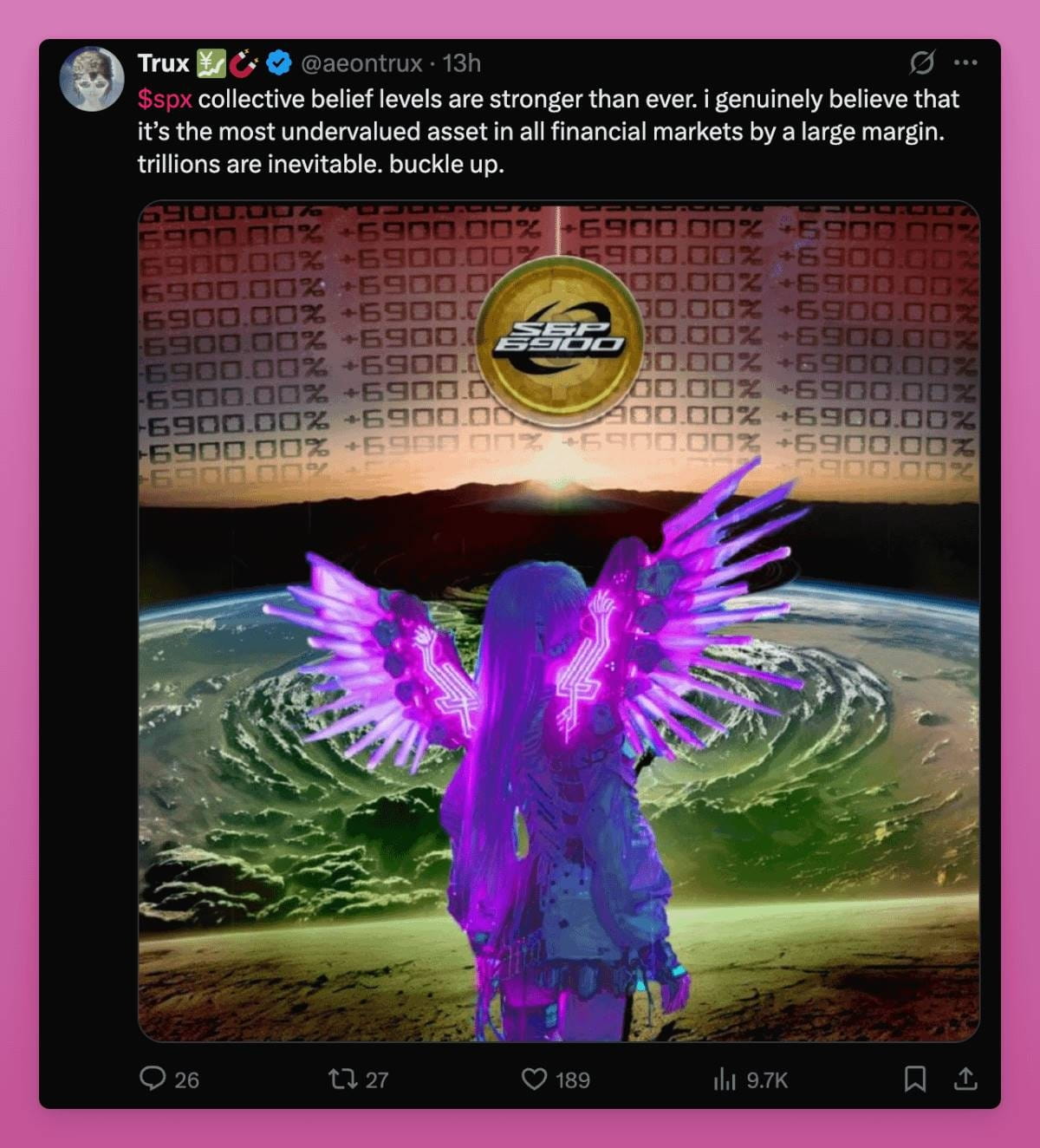
Murad's story focuses on the same opening contrast with the non-crypto crowd: if you don't invest, AI will take your job, and you will become NGMI.
Of course, you might think this is a bit of a scam, but he is holding these tokens, unlike others who quickly sell them off to their community.
Cryptocurrency founders have much to learn from him.
Disclaimer: I do not hold this token.
Pudgy Penguins
Pudgies are my favorite crypto brand.
Who wouldn't like them? They are cute, their prices are rising (my NFT only cost $2,000), and their mission is to spread 'good vibes' into the metaverse.
With billions of views on social media, Pudgy Penguins are most likely to become the best ambassadors for the crypto world.
Importantly, $PENGU is the first truly crypto-native memecoin, while other memecoins (DOGE, PEPE, SHIBA) have migrated from Web2.
Thus, Pudgy Penguins became our PR representative to fix the negative image, perhaps it's time.
Worldcoin
You may not like their quirky AI scanning balls or criticize their 'squeeze' tokenomics, but one thing is undeniable: their ambition.
The mission of World Proof of Human is to establish a global identity and financial network to distinguish between online humans and AI while promoting global economic participation.
This is also one of the core missions of cryptocurrency.
Farcaster
Farcaster's X introduction may be the least ambitious-sounding introduction among all crypto projects: "a sufficiently decentralized social network."
"Sufficiently decentralized" may not sound very ambitious. But Farcaster quietly achieved it.
It's building an open social network similar to X, but with censorship resistance and user ownership.
Instead of putting everything on-chain and sacrificing user experience, it only decentralized the key parts: usernames, messages, and the reading and writing permissions of the network.
This is enough to ensure freedom while avoiding the disadvantages of complete decentralization.
Anyone can build applications on its foundation, and no one can remove you from the platform. While certain front-end user interfaces may ban you, users can easily migrate to other platforms.
Base has proven through its latest Base application that the Farcaster approach is valid.
Can't wait to see its token go live!
Hyperliquid
This seems like an obvious choice.
However, it wasn't until OKX + Binance tried to suppress Hyperliquid that I truly became a believer.
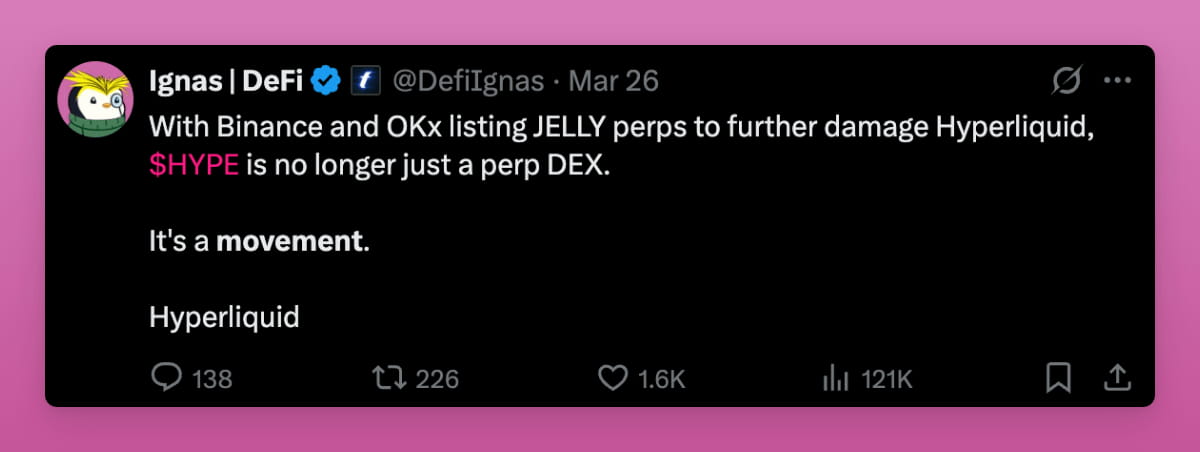
Today, HYPE has become a movement aimed at shifting all trading from centralized exchanges (CEX) to decentralized exchanges (DEX).
Even surpassing Binance. Isn't that ambitious and full of dreams?
HL has already become strong in the perpetual bond market, but I believe they will become even stronger in the spot market.
Hyperliquid.
Polymarket
The cost and time required to create false information or spread fake news are minimal.
But answering questions like 'Do vaccines cause autism?' requires billions in research funding and a lot of time.
The truth is indeed expensive. In an era filled with fake news and AI content, revealing what really happens is more valuable than ever.
Polymarket's strength has long been validated: it has outperformed traditional media in predicting U.S. election results.
This is why Polymarket has become one of the protocols that makes me dream of 'big dreams.' Looking forward to their token airdrop!
Liquity
Since the collapse of Terra, most people have given up on the dream of building a truly decentralized stablecoin.
Maker has turned to traditional finance (TradFi) and real-world assets (RWAs); even the illegal stablecoin Rai that Vitalik Buterin once championed chose to transform.
Liquity may be our last chance to achieve a truly decentralized stablecoin with minimal governance.
Although Liquity V2 is slowly growing, its total value locked (TVL) is only $136 million, and the market cap of LQTY is less than $100 million.
In terms of adoption, Liquity still has a long way to go, but their vision is inspiring. One day, the crypto world will need a decentralized stablecoin again.
Higher, further.
Fluid
Listen, I know I'm their ambassador, but there's a reason why Fluid is the only project I'm personally involved in.
When they announced their goal to surpass Uniswap in trading volume, I was both surprised and encouraged — after all, they are focused on lending protocols.
And one day, Fluid did indeed briefly surpass Uniswap on Ethereum.
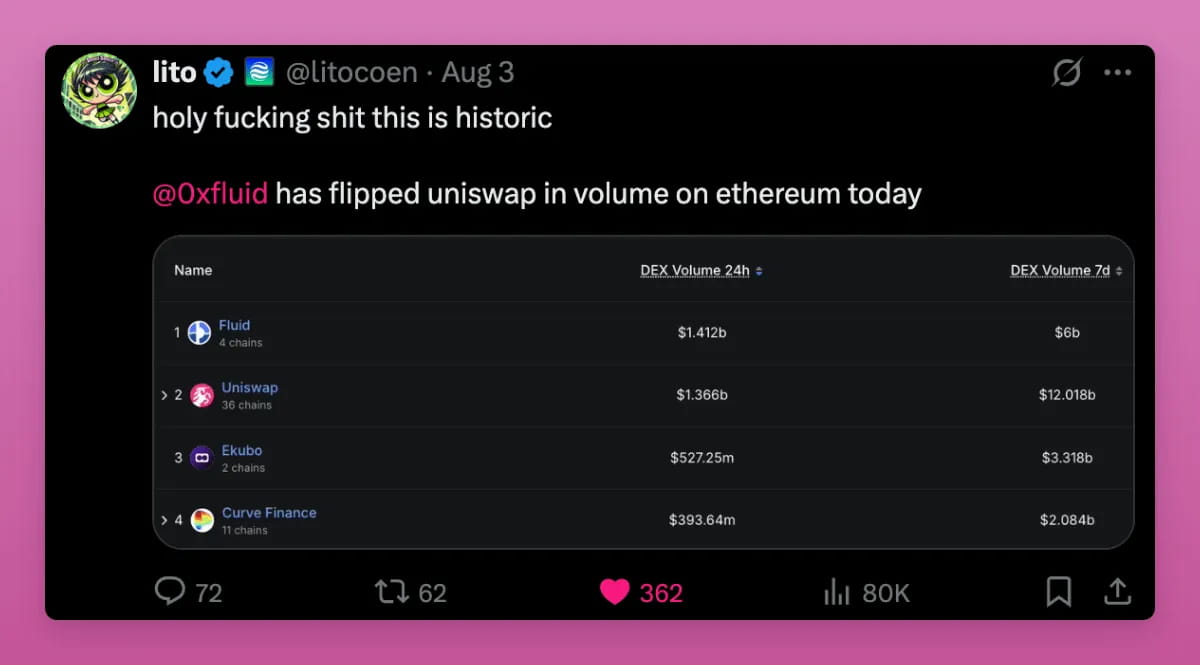
With the recent launch of Fluid DEX Lite, I expect the trading volume, total value locked (TVL), and $FLUID price to reach new heights.
Which projects or tokens inspire you with dreams? Feel free to share in the comments!
Raise your goals
The 2017/18 crypto cycle was the pinnacle of dreams.
Every token has grand ambitions: Uber, Airbnb on the blockchain, IoT (IOTA), supply chain management (VeChain), decentralized advertising markets (Brave), decentralized banking (Bankera), etc.
However, these remain at the white paper level, lacking technical support.
The situation in 2020/21 was different: the vision of decentralized finance (DeFi) and self-governance was supported by smart contracts and truly decentralized applications (dApps).
However, the governance of decentralized autonomous organizations (DAOs) and true on-chain decentralization has yet to be realized, and DeFi has gradually evolved into on-chain finance.
Today's cycle focuses on external factors: ETFs, real-world assets (RWAs), and regulation.
The dreams within the crypto industry have become smaller, and price expectations have also shrunk, despite the many positive news over the years.
We are at a crossroads of massive cryptocurrency adoption, but many refuse to pursue bigger dreams. Your price targets are too conservative.
Just NVIDIA alone has a market cap exceeding that of the entire cryptocurrency market. Nevertheless, NVIDIA's stock price has risen by 604% over the years.
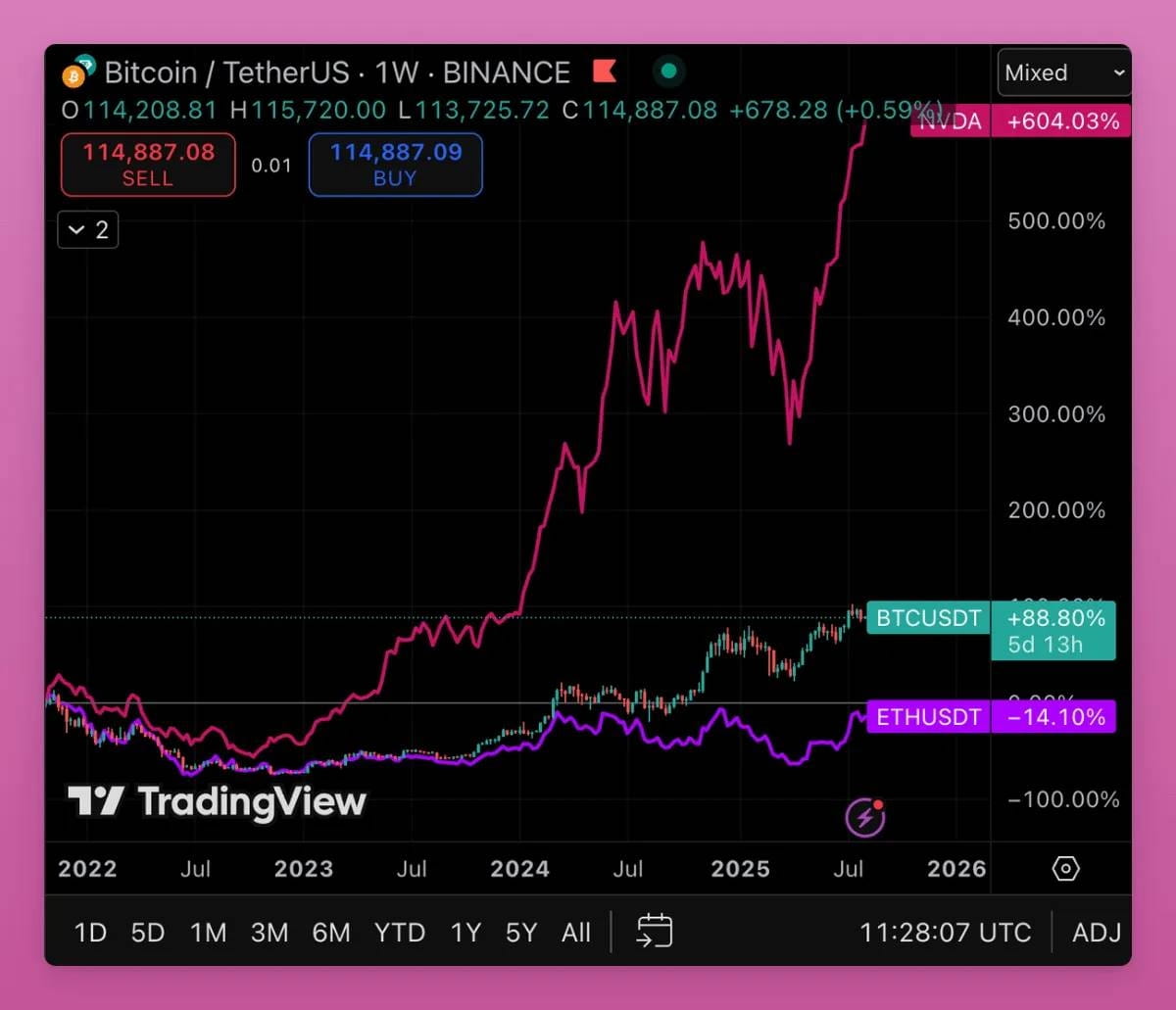
With supportive regulatory policies for crypto and active adoption by traditional finance (TradFi), the crypto industry is moving towards a new era.
It's time to amplify your dreams and raise your goals several times! The future of the crypto world is broader than you think.
